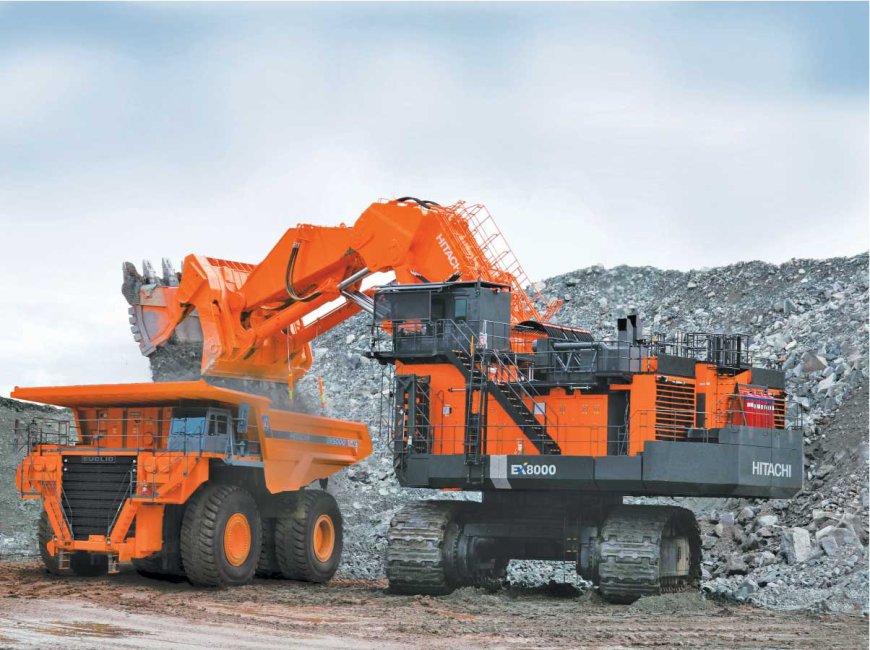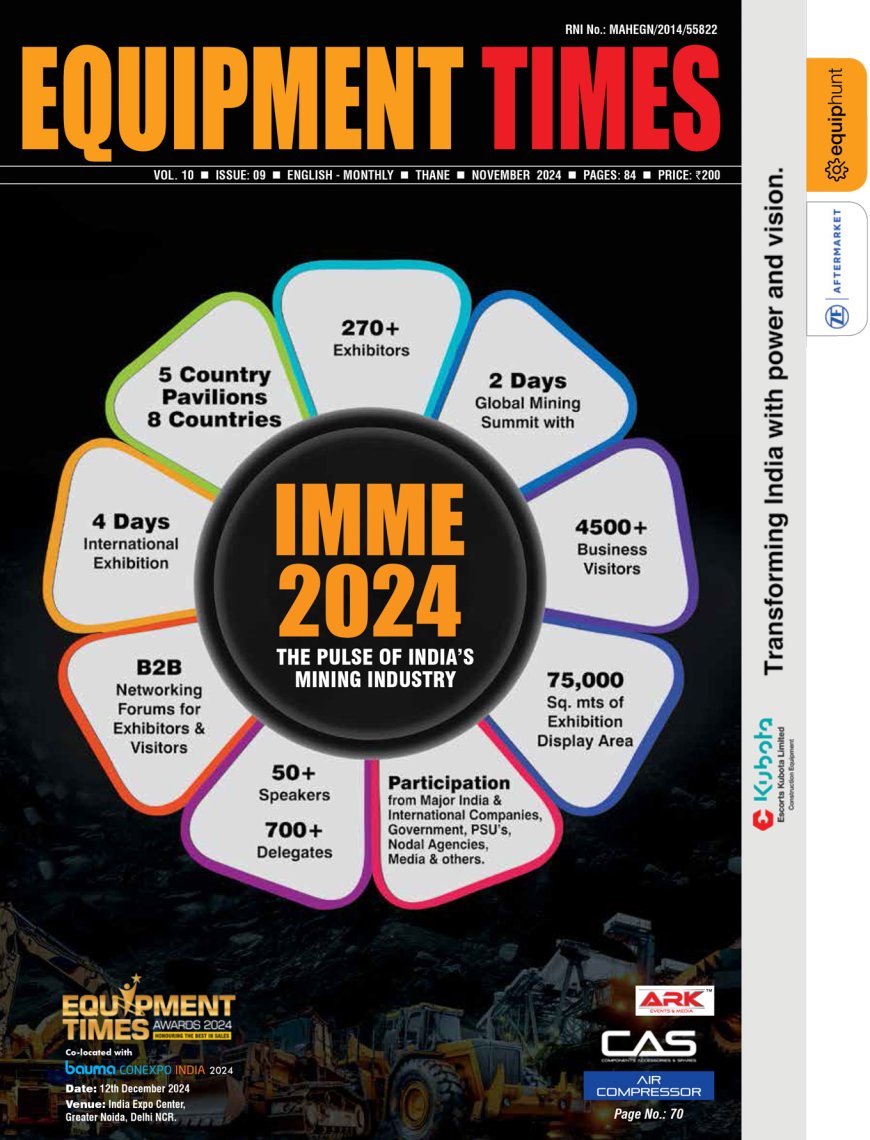THRUSTING FORWARD!
Equipment Times looks into the Demand Trends and Market Share, Rental Services, Segment Analysis, Technology, Chellenges & New Avenues of Earth-Moving Equipment in the construction and mining sector. The demand for earth-moving equipment is driven by the demand for excavators,

Equipment Times looks into the Demand Trends and Market Share, Rental Services, Segment Analysis, Technology, Chellenges & New Avenues of Earth-Moving Equipment in the construction and mining sector.
The demand for earth-moving equipment is driven by the demand for excavators, loaders, dumper trucks across the construction and mining sectors. Earthmoving machinery includes heavy machinery that are used for excavating, grading rock and soil and others. Generally, these equipment are considered to be an important resource for quarrying and demolishing activities which are expected to grow with the residential and industrial development. Rental services for these equipment are also gaining traction across the market.
Outlook and growth drivers…
 Speaking about the demand outlook and the growth drivers for earth-moving equipment of different capacities for general construction, roads and highways and mining sector, Rahul Shorey – Head – Sales, Construction Equipment, Tata Hitachi Construction Machinery, said, “With the government’s continued focus and significant investment in infrastructureand the rapid construction of national highways hitting over 60kms per day in Q4, the CE industry grew by more than 35% in the 2nd half of FY21. This led to the overall CE industry growing by 9% despite the lockdown. This year in Budget 2021, the Govt announced an increase of more than 25% in Capex amounting to Rs. 5.54 lakhcrores, most of which is in infrastructure development. Significant investments were announced in Roads and highways, highspeed rail, capacity expansion and Dedicated Freight Corridors (DFC) in Railways,apart from other initiatives like PM Gram Sadak Yojana, PM Awas Yojana, AMRUT, metro rail and Urban Swachh Bharat Mission. A significant increase was seen in allocation for Water supply through the Jal Jeewan mission amounting to Rs. 50,000 crores.We expect that all these will drive the CE industry growth this year. The mining sector is expected to continue to be a driver of sustained demand, on the back of coal mine overburden contracts awarded last year to enable quick increase in coal production. An additional demand is expected from Coal India’s accelerated investment in coal production, as well as iron ore mines auctioned in March 2020, which are also currently starting to operationalize. Demand is also forthcoming from limestone mining as cement companies are in the process of modernizing their fleets to prepare for future supply.”
Speaking about the demand outlook and the growth drivers for earth-moving equipment of different capacities for general construction, roads and highways and mining sector, Rahul Shorey – Head – Sales, Construction Equipment, Tata Hitachi Construction Machinery, said, “With the government’s continued focus and significant investment in infrastructureand the rapid construction of national highways hitting over 60kms per day in Q4, the CE industry grew by more than 35% in the 2nd half of FY21. This led to the overall CE industry growing by 9% despite the lockdown. This year in Budget 2021, the Govt announced an increase of more than 25% in Capex amounting to Rs. 5.54 lakhcrores, most of which is in infrastructure development. Significant investments were announced in Roads and highways, highspeed rail, capacity expansion and Dedicated Freight Corridors (DFC) in Railways,apart from other initiatives like PM Gram Sadak Yojana, PM Awas Yojana, AMRUT, metro rail and Urban Swachh Bharat Mission. A significant increase was seen in allocation for Water supply through the Jal Jeewan mission amounting to Rs. 50,000 crores.We expect that all these will drive the CE industry growth this year. The mining sector is expected to continue to be a driver of sustained demand, on the back of coal mine overburden contracts awarded last year to enable quick increase in coal production. An additional demand is expected from Coal India’s accelerated investment in coal production, as well as iron ore mines auctioned in March 2020, which are also currently starting to operationalize. Demand is also forthcoming from limestone mining as cement companies are in the process of modernizing their fleets to prepare for future supply.”
Shorey further added, “However, we should bear in mind that with the onset of the 2nd wave of COVID in Apr21 and the ensuing lockdown, CE sales were again hit in April and May. State and District-wise lockdowns have only been partially lifted as of now and movement of people remains restricted in some parts of the country. Controlling any further spread of the virus remains the key to reviving economic growth which will lead to a demand in the construction sector. Therefore, we expect a 10% growth of the CE industry this year against the earlier estimate of 15%, provided we can manage future waves effectively. In terms of demand outlook for major categories of construction equipment, we expect excavators – used in general construction, roads,and highways – to grow around 15% because of sustained investments.Mining equipment is expected to grow even faster given the smaller base. This year saw the implementation of CEV4 emission norms for wheeled construction equipment effective from April. This has increased the cost of the equipment by around 10%. Hence, we expect a flat to slight negative growth of both backhoe loaders and wheel loaders.”
Rental services…
Rental services are now gaining more traction across the market and local companies and SMEs likely prefer the rental service business in order to establish their business and generate revenue from the small, medium and large contractors. Speaking on the demand scenario from the rental contractors, he said, “The CE market in India lags vis-a-vis global counterparts in having an efficient and sizeable Rental Business model. Post COVID, there will be a move to expand this business as companies will shift to efficient allocation of resources and capital. Having said that, we must bear in mind that while the potential for growth in rentals is significant, in India this business is still at a very nascent stage and is mostly concentrated in the unorganized sector. We are however, seeing an initial movement towards organized rentals and the benefits of cost, quality, customization being recognized. We have already started our rental business on a pilot scale last year and look to expand it with machines and special attachments and customization. These will be backed by a commitment on upkeep of the rental units and an assurance of usage hours.”
Segment analysis…
When asked which segment is gaining maximum importance for earth-moving equipment across operations like mining, quarrying, demolition and which earth-moving equipment is holding the maximum share in these operations, Shorey explained, “All the above segments have their unique characteristics and different levels of use of earthmoving equipment. Mining operations involve a range of earthmoving equipment,excavators of 35-tonne capacityand above,as well as dumpers, wheel loaders, dozers,and others. This segment has a low base but shows huge potential for growth. From a revenue perspective, this is one of the most important segments of earthmoving equipment given the higher unit value of the same. In the mining range of excavators 45T class has the maximum share of the market. Quarrying consists of two sub segments – stone quarrying and granite quarrying.Typically, 20-tonneand 35-tonne excavators, drillsand other equipment are used in this segment. This is a very important and high-volume driver of demand for excavators.We are observing consolidation in stone quarrying, leading to customers preferring reliableand productive equipment as well as a shift to 35-tonne class excavators. Demolition segment is an emerging area of opportunity and uses specialized equipment and attachments. This is a niche segment, but with modern methods being gradually used, the growth is this segment is high.Typically, excavators with rock breakers are a very popular class of equipment in this segment. Other equipment’s include long reach demolition attachment on excavators.”
Technology…
Commenting on how disruptive technologies in the range of earth-moving equipment has driven the growth of these machines, he said, “In terms of technologies, it can broadly be categorized into two segments of growth drivers. First, our new range of machines like mini excavators are becoming popular as customers have started appreciating their unique utility andadvantages for a wide range of applications and cost effectiveness over backhoe loaders. This movement which started withniche applications,has drivengrowth by 20% CAGR over the last 5 years and it continues to grow faster than the broader market.Integrated technology like AI/ML, IoT and telematicsis also being increasingly appreciated by our customers which is adding to growth of machines with this feature. The other segment includes various attachments. These started as standalone attachments like rock breaker, auger, and drill to name a few, on base construction equipment’s. However, their increased popularity is now leading to factory fitted machines with these attachments, to enable customersto get hassle free quality equipment. In addition, specialized attachments like long reach booms and attachments used for well digging and other applications are further driving growth.”
Sales support initiative…
Shorey said, “Sales support initiatives have always remained an important part of our focus from the very beginning. And we have been continuously upgrading our infrastructure and investment in customer support. To enable us to be close to the customer, our support network includes 43 domestic andthree international dealers, having over 200 touchpoints. We have a central call center that customers can access for any support related issues.These are then forwarded to the closest dealer and monitored till closure. We have in place an ongoing machine inspection program by our engineers – especially for out of warranty equipment – to check and recommend necessary repairs or replacement of parts. This goes a long way to anticipate andminimize breakdown and unnecessary downtime. Our unique Field diagnostic Vehicles (FDV) enable our engineers to reach customer sites faster andprovide faster diagnosisas well as quicker service. We have also, through our dealer partners, started a mobile van service where speedy overhaul and repair is offered to select customer locations. We also offer remanufactured components covering critical parts like engines, hydraulic aggregates, among others, that can be quickly accessed by our customers. Customer support also involves offering customized solutions to customers depending on their needs, like Annual service contracts (ASC), Annual Maintenance Contracts (AMC), and Full maintenance contracts (FMC). We have set up skill development centers and Operator Training Schools at Kharagpur and Dharwad. These provide hands-on training for operators to sharpen their skill setsfor efficient operations and to keep them abreast of the latest technologies.
All these ensurethat after-sales support and services including spare parts supply reach our customers when needed thereby enhancingour brand value.”
Challenges and possible new avenues…
On the challenges, risk factors and possible new avenues in the earth-moving equipment segment, Shorey said, “To first look at the risk factors: state anddistrict-wise lockdowns have only been partially lifted as of now and movement of people remains restricted in some parts of the country. Controlling any further spread of the virus remains the key as far as reviving economic growth and demand in the construction sector go. Although the government has announceda record investment in infrastructure this year, the second wave of COVID and the likelihood of further waves have made the government shift focus towards investment in healthcare infrastructure. The temporary economic slowdown is going to have some impact on the government’s revenues this year. Further, with the increased allocation of funds for healthcare and other measures to support economically weaker sections, adherence to fiscal deficit is likely to come under pressure, which may lead to a reduction in some capital investments later in the year. The major continuing challenges include a steep rise in commodity prices, especially steel,which has put enormous pressure on CE manufacturers, who have been forced to pass this on to customers.This has increased costs in the entire construction value chain, and has also put pressure on margins for OEMs, which has in turnput pressure on future investments. In addition, customers may defer procurement due to increased costs, putting further pressure on revenues of CE manufacturers. Increased cost of freight – both inland as well as sea–will also affect exports as our products become uncompetitive. Although the government is committed to the National Investment Pipeline (NIP) for targeting investments in infrastructure till FY24-25, a long-term plan for investments and activities in infrastructure over the next 10 years or so will significantly guide CE manufacturers in planning for the future. The government is implementing emission standards at a fast pace in trying to catch up with the rest of the world as well reduce impact on health of the citizens. However, the transition period is as little as three years,making it difficult for manufacturers to managing the change and recover investments.In case of non-road construction equipment, there are still no clear timelines in transitioning to the new emission norms.”
He further added, “The industry has invested in training infrastructurebelieving in the Skill India program for operatorsand to impart training in correct and efficient ways of operating and maintaining machines. However, the reimbursement of this training hardly covers the cost. In terms of new avenues of potential growth, we can see that as the construction industry matures and the parameters of improved quality and timely delivery take precedence, the market for a range of attachments as well as customized machines will open up and expand. Further, new applications in railways and handling of end-of-lifevehiclesin line with the government’s scrap policy should drive growth in specialized equipment. There is significant potential in the nearly 50% of Bharatmala project still to be executed, which is expected to be completed at an accelerated pace.Increased urbanization, modernization of agriculture are other opportunities that will drive and widen the scope of use of construction equipment. Finally, the continued importance of coal in powering the country’s economy and liberalization measures like implementation of commercial coal mining,and modernization and replacement of Coal India’s ageing fleet offer further avenues for growth of mining equipment.”
Digital excavation for urban development
Urbanization is the keyword in today’s construction world. This sector has gained substantial global significance. Thus, earthmoving equipment are in high demand across the globe. Manufacturers have played a significant role and thus gained a considerable market share in these sectors too. As per reports construction industry accounts for more than 10% of Global GDP as recorded in 2017. With the increase in demands over the wider population, this industry plays a significant role in the upliftment of society. Construction projects are high to shape and build the outlook of one’s economy in structures to gain global importance; developing nations are also coming up with massive infrastructure and big projects. This upliftment shapes the glamour image of the country, thus attracting market opportunities. In addition, specific developmental projects laid down by the government have gathered immense importance nowadays. Therefore, it is clear that the construction industry has seen an enormous boom before the pandemic hit the world and aims to grow higher and conquer a major share in contributing to the economy.
An increase in demand leads to growth
 According to Saurabh Kulkarni, Mobile Automation Industry Expert, B&R Industrial Automation, “It is often seen the urban development projects have started with full force everywhere, whether building roads, complexes, or bridges; these projects have made life easy for people and united everything geographically. Now, moving on roads or crossing rivers to get to another city has made lives easy and has grown our economy. The world population has grown significantly, and our economies have become more industrialized over the past few years. Thus, as a result, many more people have moved into cities. Construction industries have to cope with the rapid growth to embark on great heights and combat competition, so we can say automation is needed everywhere. As this sector is driven by time and money, each second and every penny is important. For the constant rise in demand, this industry is exploring technology to its core. Automation and digital technologies provide novel ways of visualizing cities and buildings. We now see data-driven outputs, well-designed mechanical equipment types, less machine error and downtime, and plenty of resources to implement autonomous functions for construction vehicles or self-driving transport systems. One significant benefit of automation in construction is the potential for quite a significant productivity improvement. Automation and robotics carry out jobs, which are much more accessible and hardly done by laborers; it also declines costs and increases efficiency and productivity. Big giants contributing to this industry have now fully automated themselves. Looking at the pace of work and public demand, it is obvious that automation is the main driving force in today’s digital world, which has simplified human worries. Thus, it is pretty clear that as the demand grows, the pace of work increases, and to facilitate it to gain productivity, automation upticks the construction sector. B&R focuses on this sector, contributing largely by implementing new generation connectivity and data-driven technology.”
According to Saurabh Kulkarni, Mobile Automation Industry Expert, B&R Industrial Automation, “It is often seen the urban development projects have started with full force everywhere, whether building roads, complexes, or bridges; these projects have made life easy for people and united everything geographically. Now, moving on roads or crossing rivers to get to another city has made lives easy and has grown our economy. The world population has grown significantly, and our economies have become more industrialized over the past few years. Thus, as a result, many more people have moved into cities. Construction industries have to cope with the rapid growth to embark on great heights and combat competition, so we can say automation is needed everywhere. As this sector is driven by time and money, each second and every penny is important. For the constant rise in demand, this industry is exploring technology to its core. Automation and digital technologies provide novel ways of visualizing cities and buildings. We now see data-driven outputs, well-designed mechanical equipment types, less machine error and downtime, and plenty of resources to implement autonomous functions for construction vehicles or self-driving transport systems. One significant benefit of automation in construction is the potential for quite a significant productivity improvement. Automation and robotics carry out jobs, which are much more accessible and hardly done by laborers; it also declines costs and increases efficiency and productivity. Big giants contributing to this industry have now fully automated themselves. Looking at the pace of work and public demand, it is obvious that automation is the main driving force in today’s digital world, which has simplified human worries. Thus, it is pretty clear that as the demand grows, the pace of work increases, and to facilitate it to gain productivity, automation upticks the construction sector. B&R focuses on this sector, contributing largely by implementing new generation connectivity and data-driven technology.”
Importance of Earthmoving Equipment
Heavy equipment is the primary source to carry construction jobs of almost any size, from home building to large-scale commercial and civil projects. Earthmoving equipment covers a broad range of machines that can excavate and grade rock and soil along with other jobs. “Earthmovers and other heavy equipment help in earthwork as well as materials handling, demolition, and construction work. Many types of heavy construction equipment are designed for various functions, making them indispensable on job sites. Cost savings and profitability lead to increased productivity and reliability of earthmoving equipment, which gives a leap to higher profitability from fewer defect-related claims, and the avoidance of delay penalties. In addition, using automated earthmoving equipment can significantly reduce the cost of large-scale projects. This helps increase output rate through the increase in work progress, including the best practical and efficient methods, and reduces the overall construction costs, especially for large contracts. A machine can do tasks, which are too heavy or too delicate for human muscles to do quickly. Over the years, it has been seen, these sectors do need human labor, but this has not been limited to the importance of machines. Machines here have increased human productivity too. Bulldozers, skid steer loaders, trenchers, backhoe loaders, etc., are those monsters who make digging trenches, excavating, and loading heavy materials very easy. These specific tasks, even if we gather huge groups, are not possible single-handedly,” Saurabh said.
He further added, “Preventing unexpected downtime is one of the foremost priorities. To this end, rotating components like hydraulic pumps, motors, and gearboxes are traditionally over-engineered or replaced at conservatively short intervals. Construction companies keep a sizable stock of replacement parts nearby with additional costs at hand to keep any unavoidable downtime. These costs can be reduced by applying modern approaches to analytics and maintenance. Manufacturers of this equipment are constantly exploring and investing in their design and R&D, mainly to overcome the competition in the market. B&R, in this regard, supports such big machine manufacturers by providing product and technology knowledge, which is important in handling the products and constantly upgrading the product range to cope with the market demand and help and support these manufacturers to sustain market value with equivalent share.”
Sector growth leads to business ramp-up
During recent times this sector has evolved in many directions. Sector growth leads to a country’s economic stability and a significant increase in the monetary measure of the market value of all the final goods and services produced in a specific period (GDP). In recent years, sector revenue has grown and aims to grow exponentially as the economy begins to recover from the current situation. Business ramp-up solely depends on one’s market stability and sustainability. Construction equipment manufacturers contribute heavily and invest a large chunk of money and time. Manufacturers contributing to big giants of construction are making things easy and digitizing everything around it. Implementing Industrial IoT is one of the best booms to industry. IoT in construction has vast potential to reduce accidents, using digital solutions like sensors, robots, etc. Rooting to the digitization and the introduction of technology has ramped up the industry growth. Product and technology-contributing companies like B&R and others contribute to sector growth by emerging with new technologies, products, and improved high-end network connectivity, helping manufacturers and industries grow and capture market opportunities.
Overcoming challenges with B&R product portfolio: Mobile Automation
Saurabh states B&R is constantly improving and investing a lot in research and development. Thus, viewing the Construction industry growth, the product portfolio Mobile Automation was explicitly designed for big giants of the construction business. “The modular X90 control system with integrated safety technology is perfect for implementing flexible automation. The heart of the X90 control system is a powerful ARM processor and multifunction I/O channels. X90 family is designed for use in harsh industrial environments. It can handle operating temperatures from -40 +85°C and resist environmental factors such as shock and vibration, salt, UV light, and oil. Another highlight of the B&R booth will be the compact and rugged Power Panel T50 mobile operator terminal. The panel offers the highly reliable operation of mobile equipment and vehicles with IP67 protection against all types of environmental influences. The new Automation PC Mobile 3100 is a significant highlight among the designed portfolio for heavy industry. B&R’s mobile automation PC provides the combination of performance and robust form factor to handle the increasing demands of modern off-highway equipment applications. In addition, the powerful PC for mobile machinery is equipped with an Intel Core i processor and offers IP69K protection for deployment in harsh environments. Its high performance makes it optimally suited for intelligent machines that communicate with each other, process data, and send it to the cloud. Higher efficiency goals in construction, forestry, and mining applications mean more data to be collected and managed from multiple machines. The Automation PC mobile 3100 covers all up implementing productive results.”



Hits: 141











